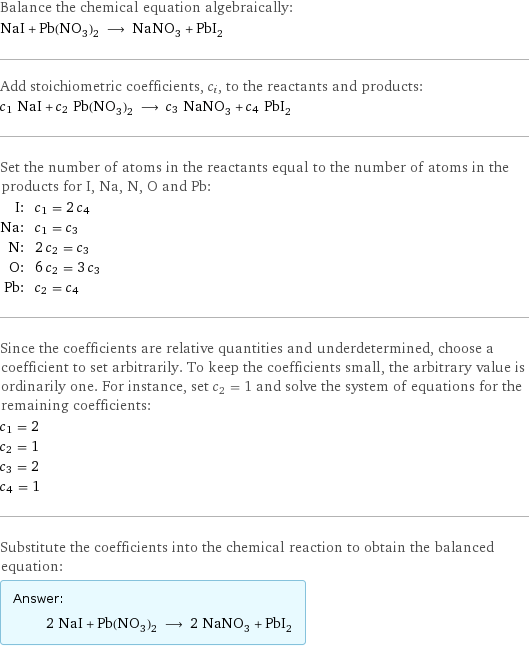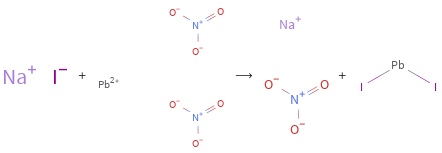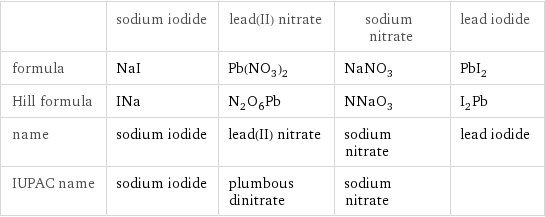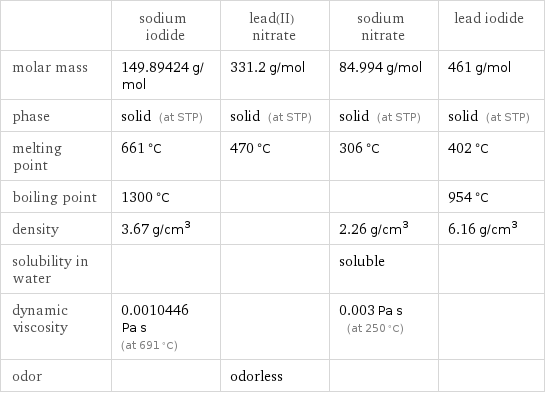Input interpretation

NaI sodium iodide + Pb(NO_3)_2 lead(II) nitrate ⟶ NaNO_3 sodium nitrate + PbI_2 lead iodide
Balanced equation

Balance the chemical equation algebraically: NaI + Pb(NO_3)_2 ⟶ NaNO_3 + PbI_2 Add stoichiometric coefficients, c_i, to the reactants and products: c_1 NaI + c_2 Pb(NO_3)_2 ⟶ c_3 NaNO_3 + c_4 PbI_2 Set the number of atoms in the reactants equal to the number of atoms in the products for I, Na, N, O and Pb: I: | c_1 = 2 c_4 Na: | c_1 = c_3 N: | 2 c_2 = c_3 O: | 6 c_2 = 3 c_3 Pb: | c_2 = c_4 Since the coefficients are relative quantities and underdetermined, choose a coefficient to set arbitrarily. To keep the coefficients small, the arbitrary value is ordinarily one. For instance, set c_2 = 1 and solve the system of equations for the remaining coefficients: c_1 = 2 c_2 = 1 c_3 = 2 c_4 = 1 Substitute the coefficients into the chemical reaction to obtain the balanced equation: Answer: | | 2 NaI + Pb(NO_3)_2 ⟶ 2 NaNO_3 + PbI_2
Structures

+ ⟶ +
Names

sodium iodide + lead(II) nitrate ⟶ sodium nitrate + lead iodide
Reaction thermodynamics
Enthalpy

| sodium iodide | lead(II) nitrate | sodium nitrate | lead iodide molecular enthalpy | -287.8 kJ/mol | -451.9 kJ/mol | -467.9 kJ/mol | -175.5 kJ/mol total enthalpy | -575.6 kJ/mol | -451.9 kJ/mol | -935.8 kJ/mol | -175.5 kJ/mol | H_initial = -1028 kJ/mol | | H_final = -1111 kJ/mol | ΔH_rxn^0 | -1111 kJ/mol - -1028 kJ/mol = -83.8 kJ/mol (exothermic) | | |
Equilibrium constant
![Construct the equilibrium constant, K, expression for: NaI + Pb(NO_3)_2 ⟶ NaNO_3 + PbI_2 Plan: • Balance the chemical equation. • Determine the stoichiometric numbers. • Assemble the activity expression for each chemical species. • Use the activity expressions to build the equilibrium constant expression. Write the balanced chemical equation: 2 NaI + Pb(NO_3)_2 ⟶ 2 NaNO_3 + PbI_2 Assign stoichiometric numbers, ν_i, using the stoichiometric coefficients, c_i, from the balanced chemical equation in the following manner: ν_i = -c_i for reactants and ν_i = c_i for products: chemical species | c_i | ν_i NaI | 2 | -2 Pb(NO_3)_2 | 1 | -1 NaNO_3 | 2 | 2 PbI_2 | 1 | 1 Assemble the activity expressions accounting for the state of matter and ν_i: chemical species | c_i | ν_i | activity expression NaI | 2 | -2 | ([NaI])^(-2) Pb(NO_3)_2 | 1 | -1 | ([Pb(NO3)2])^(-1) NaNO_3 | 2 | 2 | ([NaNO3])^2 PbI_2 | 1 | 1 | [PbI2] The equilibrium constant symbol in the concentration basis is: K_c Mulitply the activity expressions to arrive at the K_c expression: Answer: | | K_c = ([NaI])^(-2) ([Pb(NO3)2])^(-1) ([NaNO3])^2 [PbI2] = (([NaNO3])^2 [PbI2])/(([NaI])^2 [Pb(NO3)2])](../image_source/32259771d862f096415d3b79cdbb4f3e.png)
Construct the equilibrium constant, K, expression for: NaI + Pb(NO_3)_2 ⟶ NaNO_3 + PbI_2 Plan: • Balance the chemical equation. • Determine the stoichiometric numbers. • Assemble the activity expression for each chemical species. • Use the activity expressions to build the equilibrium constant expression. Write the balanced chemical equation: 2 NaI + Pb(NO_3)_2 ⟶ 2 NaNO_3 + PbI_2 Assign stoichiometric numbers, ν_i, using the stoichiometric coefficients, c_i, from the balanced chemical equation in the following manner: ν_i = -c_i for reactants and ν_i = c_i for products: chemical species | c_i | ν_i NaI | 2 | -2 Pb(NO_3)_2 | 1 | -1 NaNO_3 | 2 | 2 PbI_2 | 1 | 1 Assemble the activity expressions accounting for the state of matter and ν_i: chemical species | c_i | ν_i | activity expression NaI | 2 | -2 | ([NaI])^(-2) Pb(NO_3)_2 | 1 | -1 | ([Pb(NO3)2])^(-1) NaNO_3 | 2 | 2 | ([NaNO3])^2 PbI_2 | 1 | 1 | [PbI2] The equilibrium constant symbol in the concentration basis is: K_c Mulitply the activity expressions to arrive at the K_c expression: Answer: | | K_c = ([NaI])^(-2) ([Pb(NO3)2])^(-1) ([NaNO3])^2 [PbI2] = (([NaNO3])^2 [PbI2])/(([NaI])^2 [Pb(NO3)2])
Rate of reaction
![Construct the rate of reaction expression for: NaI + Pb(NO_3)_2 ⟶ NaNO_3 + PbI_2 Plan: • Balance the chemical equation. • Determine the stoichiometric numbers. • Assemble the rate term for each chemical species. • Write the rate of reaction expression. Write the balanced chemical equation: 2 NaI + Pb(NO_3)_2 ⟶ 2 NaNO_3 + PbI_2 Assign stoichiometric numbers, ν_i, using the stoichiometric coefficients, c_i, from the balanced chemical equation in the following manner: ν_i = -c_i for reactants and ν_i = c_i for products: chemical species | c_i | ν_i NaI | 2 | -2 Pb(NO_3)_2 | 1 | -1 NaNO_3 | 2 | 2 PbI_2 | 1 | 1 The rate term for each chemical species, B_i, is 1/ν_i(Δ[B_i])/(Δt) where [B_i] is the amount concentration and t is time: chemical species | c_i | ν_i | rate term NaI | 2 | -2 | -1/2 (Δ[NaI])/(Δt) Pb(NO_3)_2 | 1 | -1 | -(Δ[Pb(NO3)2])/(Δt) NaNO_3 | 2 | 2 | 1/2 (Δ[NaNO3])/(Δt) PbI_2 | 1 | 1 | (Δ[PbI2])/(Δt) (for infinitesimal rate of change, replace Δ with d) Set the rate terms equal to each other to arrive at the rate expression: Answer: | | rate = -1/2 (Δ[NaI])/(Δt) = -(Δ[Pb(NO3)2])/(Δt) = 1/2 (Δ[NaNO3])/(Δt) = (Δ[PbI2])/(Δt) (assuming constant volume and no accumulation of intermediates or side products)](../image_source/1ed14a768ef714b81227e4de1bbb9512.png)
Construct the rate of reaction expression for: NaI + Pb(NO_3)_2 ⟶ NaNO_3 + PbI_2 Plan: • Balance the chemical equation. • Determine the stoichiometric numbers. • Assemble the rate term for each chemical species. • Write the rate of reaction expression. Write the balanced chemical equation: 2 NaI + Pb(NO_3)_2 ⟶ 2 NaNO_3 + PbI_2 Assign stoichiometric numbers, ν_i, using the stoichiometric coefficients, c_i, from the balanced chemical equation in the following manner: ν_i = -c_i for reactants and ν_i = c_i for products: chemical species | c_i | ν_i NaI | 2 | -2 Pb(NO_3)_2 | 1 | -1 NaNO_3 | 2 | 2 PbI_2 | 1 | 1 The rate term for each chemical species, B_i, is 1/ν_i(Δ[B_i])/(Δt) where [B_i] is the amount concentration and t is time: chemical species | c_i | ν_i | rate term NaI | 2 | -2 | -1/2 (Δ[NaI])/(Δt) Pb(NO_3)_2 | 1 | -1 | -(Δ[Pb(NO3)2])/(Δt) NaNO_3 | 2 | 2 | 1/2 (Δ[NaNO3])/(Δt) PbI_2 | 1 | 1 | (Δ[PbI2])/(Δt) (for infinitesimal rate of change, replace Δ with d) Set the rate terms equal to each other to arrive at the rate expression: Answer: | | rate = -1/2 (Δ[NaI])/(Δt) = -(Δ[Pb(NO3)2])/(Δt) = 1/2 (Δ[NaNO3])/(Δt) = (Δ[PbI2])/(Δt) (assuming constant volume and no accumulation of intermediates or side products)
Chemical names and formulas

| sodium iodide | lead(II) nitrate | sodium nitrate | lead iodide formula | NaI | Pb(NO_3)_2 | NaNO_3 | PbI_2 Hill formula | INa | N_2O_6Pb | NNaO_3 | I_2Pb name | sodium iodide | lead(II) nitrate | sodium nitrate | lead iodide IUPAC name | sodium iodide | plumbous dinitrate | sodium nitrate |
Substance properties

| sodium iodide | lead(II) nitrate | sodium nitrate | lead iodide molar mass | 149.89424 g/mol | 331.2 g/mol | 84.994 g/mol | 461 g/mol phase | solid (at STP) | solid (at STP) | solid (at STP) | solid (at STP) melting point | 661 °C | 470 °C | 306 °C | 402 °C boiling point | 1300 °C | | | 954 °C density | 3.67 g/cm^3 | | 2.26 g/cm^3 | 6.16 g/cm^3 solubility in water | | | soluble | dynamic viscosity | 0.0010446 Pa s (at 691 °C) | | 0.003 Pa s (at 250 °C) | odor | | odorless | |
Units
